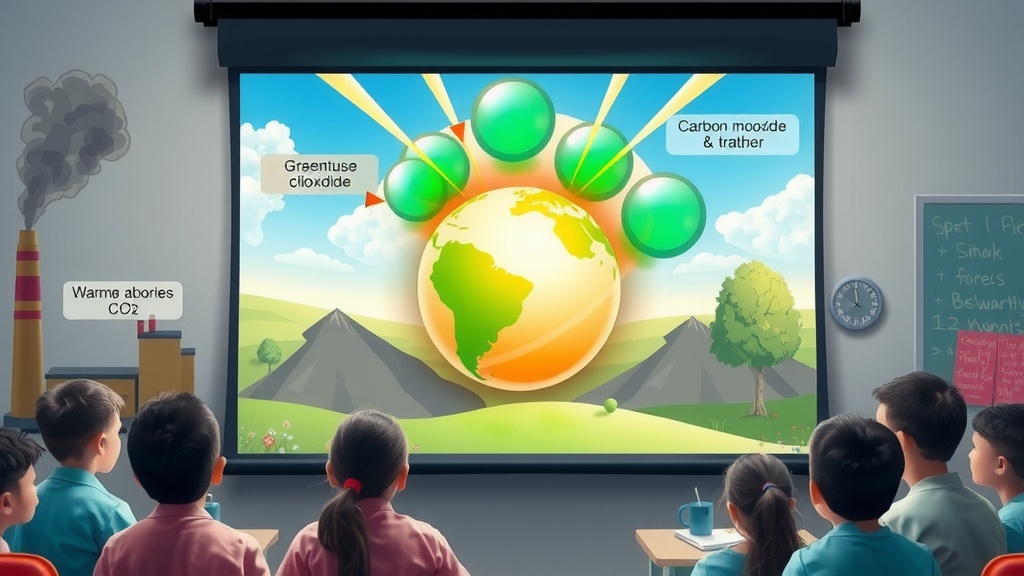Imagine Earth wrapped in a cozy blanket. Sounds nice, right? But what if that blanket got a little too cozy, trapping heat and making things uncomfortably warm? That, in a nutshell, is the greenhouse effect. It's a natural phenomenon, vital for life, but human activities are turning up the thermostat, and that's where the problem begins. Let's unwrap this topic, specifically focusing on Greenhouse Effect Paragraph for Class 6-12, SSC, HSC, 150, 250, 300 Words, and understand what's happening to our planetary blanket.
What is the Greenhouse Effect?
Think of a greenhouse – the kind where you grow tomatoes in winter. The glass roof lets sunlight in, warming the inside. But the glass also traps some of that heat, preventing it from escaping. The Earth's atmosphere acts like that glass roof, only instead of glass, we have greenhouse gases.
These gases, including carbon dioxide (CO2), methane (CH4), and nitrous oxide (N2O), allow sunlight to pass through and warm the Earth's surface. The Earth then radiates some of that heat back into space. But greenhouse gases absorb some of this outgoing heat, trapping it in the atmosphere and warming the planet. This is the greenhouse effect.
Without the greenhouse effect, Earth would be a frozen wasteland, too cold to support life as we know it. The average temperature would be around -18°C (0°F)! So, the greenhouse effect is essential, but like many good things, too much can be a problem.
Why is the Greenhouse Effect Important?
The greenhouse effect is crucial because it keeps our planet warm enough to support life. It maintains a stable temperature range, allowing water to exist in liquid form, which is essential for all living organisms. Without it, oceans would freeze, and life would be drastically different, if it existed at all.
What are Greenhouse Gases?
Greenhouse gases are the atmospheric components that trap heat. Here's a closer look at some of the most important ones:
- Carbon Dioxide (CO2): Released through burning fossil fuels (coal, oil, and natural gas), deforestation, and industrial processes. It's the most significant contributor to the enhanced greenhouse effect.
- Methane (CH4): Emitted from livestock farming, natural gas leaks, and decomposition of organic waste in landfills. Methane is a much more potent greenhouse gas than CO2, but it doesn't stay in the atmosphere as long.
- Nitrous Oxide (N2O): Released from agricultural activities, industrial processes, and burning fossil fuels. It's a very powerful greenhouse gas, with a global warming potential many times that of CO2.
- Water Vapor (H2O): While it's the most abundant greenhouse gas, its concentration in the atmosphere is largely determined by temperature. Warmer temperatures lead to more evaporation and more water vapor, creating a feedback loop.
- Ozone (O3): While beneficial in the upper atmosphere (stratosphere) where it blocks harmful UV radiation, ozone in the lower atmosphere (troposphere) acts as a greenhouse gas and contributes to air pollution.
Here's a table summarizing the major greenhouse gases:
| Greenhouse Gas | Sources | Global Warming Potential (GWP) |
|---|---|---|
| Carbon Dioxide | Burning fossil fuels, deforestation, industrial processes | 1 |
| Methane | Livestock, natural gas leaks, landfills | 25 |
| Nitrous Oxide | Agriculture, industrial processes, burning fossil fuels | 298 |
| Water Vapor | Evaporation | Variable |
| Ozone (Tropospheric) | Chemical reactions involving pollutants | Variable |
GWP measures how much energy the emissions of 1 ton of a gas will absorb over a given period of time, relative to the emissions of 1 ton of carbon dioxide (CO2).
The Enhanced Greenhouse Effect: The Problem
The problem isn't the greenhouse effect itself, but the enhanced greenhouse effect. Human activities, particularly since the Industrial Revolution, have significantly increased the concentration of greenhouse gases in the atmosphere. This means more heat is being trapped, leading to global warming and climate change.
What Causes the Enhanced Greenhouse Effect?
The primary driver of the enhanced greenhouse effect is the burning of fossil fuels. When we burn coal, oil, and natural gas to generate electricity, power our cars, and heat our homes, we release large amounts of CO2 into the atmosphere. Deforestation also contributes, as trees absorb CO2 during photosynthesis. When forests are cut down and burned, that stored carbon is released back into the atmosphere.
Other activities, such as agriculture and industrial processes, also contribute to the increase in greenhouse gas concentrations.
What are the Consequences of the Enhanced Greenhouse Effect?
The consequences of the enhanced greenhouse effect are far-reaching and potentially devastating. They include:
- Global Warming: Rising global temperatures, leading to more frequent and intense heatwaves.
- Melting Glaciers and Ice Sheets: Contributing to rising sea levels, threatening coastal communities and ecosystems.
- Sea Level Rise: Caused by thermal expansion of water and melting ice, leading to coastal erosion, flooding, and displacement of populations.
- Changes in Precipitation Patterns: Leading to more frequent and severe droughts in some areas and increased flooding in others.
- Ocean Acidification: As the ocean absorbs excess CO2 from the atmosphere, it becomes more acidic, threatening marine life, particularly shellfish and coral reefs.
- More Extreme Weather Events: Including hurricanes, cyclones, and floods.
- Disruptions to Agriculture: Changes in temperature and precipitation patterns can impact crop yields and food security.
- Impacts on Human Health: Heatwaves, air pollution, and the spread of infectious diseases can all be exacerbated by climate change.
How Does Climate Change Affect Bangladesh?
Bangladesh is particularly vulnerable to the impacts of climate change due to its low-lying geography and high population density. Some of the key impacts include:
- Sea Level Rise: Threatening coastal communities, displacing millions of people, and inundating agricultural land.
- Increased Flooding: More frequent and intense floods, damaging infrastructure, destroying crops, and spreading waterborne diseases.
- More Frequent and Intense Cyclones: Causing widespread destruction and loss of life.
- Salinity Intrusion: Contaminating freshwater sources and making it difficult to grow crops in coastal areas.
- Changes in Rainfall Patterns: Leading to droughts in some areas and increased flooding in others, impacting agriculture and water resources.
Here's a table summarizing the impacts of climate change on Bangladesh:
| Impact | Consequences |
|---|---|
| Sea Level Rise | Displacement of populations, loss of agricultural land, increased coastal erosion |
| Increased Flooding | Damage to infrastructure, destruction of crops, spread of waterborne diseases |
| Cyclones | Widespread destruction, loss of life |
| Salinity Intrusion | Contamination of freshwater sources, reduced crop yields |
| Rainfall Changes | Droughts in some areas, increased flooding in others, impacting agriculture and water resources |
What Can We Do?
While the challenges posed by the enhanced greenhouse effect are significant, there are many things we can do to mitigate its impacts.
Individual Actions
- Reduce Your Carbon Footprint: This means reducing your energy consumption, using public transportation, cycling or walking instead of driving, eating less meat, and buying locally sourced products.
- Conserve Energy: Turn off lights when you leave a room, unplug electronics when they're not in use, and use energy-efficient appliances.
- Reduce, Reuse, and Recycle: Minimize waste by reducing consumption, reusing items whenever possible, and recycling materials like paper, plastic, and glass.
- Plant Trees: Trees absorb CO2 from the atmosphere, helping to reduce greenhouse gas concentrations.
- Support Sustainable Businesses: Choose products and services from companies that are committed to environmental sustainability.
- Educate Yourself and Others: Learn more about climate change and its impacts, and share your knowledge with others.
- Advocate for Change: Support policies and initiatives that promote clean energy, reduce greenhouse gas emissions, and protect the environment.
Collective Actions
- Transition to Renewable Energy: Invest in solar, wind, and other renewable energy sources to reduce our reliance on fossil fuels.
- Improve Energy Efficiency: Implement policies and technologies to improve energy efficiency in buildings, transportation, and industry.
- Protect and Restore Forests: Prevent deforestation and promote reforestation to increase carbon sequestration.
- Develop Sustainable Agriculture Practices: Reduce greenhouse gas emissions from agriculture by using sustainable farming techniques.
- International Cooperation: Work together with other countries to address climate change through international agreements and initiatives.
Greenhouse Effect Paragraph Examples for Different Classes
Here are some sample paragraphs on the greenhouse effect, tailored for different grade levels:
Greenhouse Effect Paragraph for Class 6 (150 words)
The greenhouse effect is like a blanket around the Earth. The sun's light and heat come to Earth, and some of that heat stays with us because of gases in the air, like carbon dioxide. These gases act like the glass roof of a greenhouse, trapping the heat inside. This keeps our planet warm enough for us to live. But, when we burn too much coal and oil, we add more of these gases to the air. This makes the blanket thicker, trapping too much heat and causing the Earth to get warmer. This is called global warming, and it can cause problems like melting ice and changing weather. So, we need to use less energy and plant more trees to keep the Earth's blanket just right.
Greenhouse Effect Paragraph for Class 8 (250 words)
The greenhouse effect is a natural process that warms the Earth's surface. Certain gases in the atmosphere, known as greenhouse gases, trap heat from the sun. These gases, including carbon dioxide, methane, and water vapor, act like the glass roof of a greenhouse, allowing sunlight to enter but preventing some of the heat from escaping. This natural process keeps the Earth warm enough to support life. However, human activities, such as burning fossil fuels and deforestation, have increased the concentration of greenhouse gases in the atmosphere. This enhanced greenhouse effect is causing the Earth to warm at an alarming rate, leading to global warming and climate change. The consequences of climate change include rising sea levels, more frequent and intense heatwaves, changes in precipitation patterns, and disruptions to ecosystems. To mitigate the effects of climate change, we need to reduce our greenhouse gas emissions by transitioning to renewable energy sources, improving energy efficiency, and protecting forests.
Greenhouse Effect Paragraph for SSC/HSC (300 words)
The greenhouse effect is a naturally occurring phenomenon that plays a vital role in regulating Earth's temperature and making it habitable for life. Greenhouse gases, such as carbon dioxide, methane, and nitrous oxide, act as a thermal blanket, trapping some of the sun's heat in the atmosphere. This process is analogous to the glass roof of a greenhouse, which allows sunlight to enter but prevents heat from escaping. Without the greenhouse effect, Earth's average temperature would be significantly lower, rendering it inhospitable for most life forms. However, human activities, particularly the burning of fossil fuels for energy and deforestation, have drastically increased the concentration of greenhouse gases in the atmosphere, leading to an enhanced greenhouse effect and global warming. The consequences of this enhanced effect are far-reaching and include rising sea levels, melting glaciers, more frequent and intense extreme weather events, disruptions to agricultural systems, and threats to biodiversity. Addressing this challenge requires a multifaceted approach, including transitioning to renewable energy sources, implementing sustainable land management practices, improving energy efficiency, and fostering international cooperation to reduce greenhouse gas emissions and mitigate the impacts of climate change. Bangladesh, being a low-lying coastal nation, is particularly vulnerable to the adverse effects of climate change and requires urgent adaptation and mitigation measures.
FAQs about the Greenhouse Effect
Let's tackle some frequently asked questions about the greenhouse effect:
What is the Greenhouse Effect in Bangla? (গ্রীনহাউজ এফেক্ট কি?)
গ্রীনহাউজ এফেক্ট হলো একটি প্রাকৃতিক প্রক্রিয়া। পৃথিবীর চারপাশে কিছু গ্যাস, যেমন কার্বন ডাই অক্সাইড, মিথেন ইত্যাদি একটি আবরণের মতো তৈরি করে। সূর্যের আলো যখন পৃথিবীতে আসে, তখন এই গ্যাসগুলো সেই তাপ আটকে রাখে, যা পৃথিবীকে উষ্ণ রাখে। এটি অনেকটা গ্রীনহাউজের মতো কাজ করে, যেখানে কাঁচের ঘর সূর্যের তাপ আটকে রাখে গাছপালা বাঁচানোর জন্য। কিন্তু যখন এই গ্যাসগুলোর পরিমাণ বেড়ে যায়, তখন বেশি তাপ আটকা পড়ে এবং পৃথিবীর তাপমাত্রা বেড়ে যায়, যা পরিবেশের জন্য ক্ষতিকর।
(Translation: The greenhouse effect is a natural process. Certain gases around the Earth, such as carbon dioxide, methane, etc., create a layer like a cover. When sunlight comes to Earth, these gases trap that heat, which keeps the Earth warm. It works a lot like a greenhouse, where a glass house traps the sun's heat to save plants. But when the amount of these gases increases, more heat gets trapped and the Earth's temperature increases, which is harmful to the environment.)
Is the Greenhouse Effect Good or Bad?
The greenhouse effect itself is good. It's a natural process that's essential for life on Earth. However, the enhanced greenhouse effect, caused by human activities, is bad. It's leading to global warming and climate change, with potentially devastating consequences.
What are the Main Causes of the Greenhouse Effect?
The main causes of the enhanced greenhouse effect are:
- Burning fossil fuels (coal, oil, and natural gas)
- Deforestation
- Agricultural activities (livestock farming, fertilizer use)
- Industrial processes
How Can We Reduce the Greenhouse Effect?
We can reduce the greenhouse effect by:
- Reducing our carbon footprint
- Conserving energy
- Using renewable energy sources
- Protecting and restoring forests
- Adopting sustainable agriculture practices
- Supporting policies that promote climate action
What is the Difference Between Global Warming and the Greenhouse Effect?
The greenhouse effect is a natural process that warms the Earth. Global warming is the increase in Earth's average temperature due to the enhanced greenhouse effect, caused by human activities. So, the greenhouse effect is the mechanism, and global warming is the result of that mechanism being amplified.
What are Some Examples of Greenhouse Gases?
Examples of greenhouse gases include:
- Carbon dioxide (CO2)
- Methane (CH4)
- Nitrous oxide (N2O)
- Water vapor (H2O)
- Ozone (O3)
What is the Impact of Greenhouse Effect on Our Environment?
The impact of the greenhouse effect on our environment is significant and includes:
- Rising global temperatures
- Melting glaciers and ice sheets
- Sea level rise
- Changes in precipitation patterns
- Ocean acidification
- More extreme weather events
- Disruptions to agriculture
- Impacts on human health
How Does Deforestation Contribute to the Greenhouse Effect?
Deforestation contributes to the greenhouse effect in two main ways:
- Trees absorb CO2 from the atmosphere during photosynthesis. When forests are cut down, that stored carbon is released back into the atmosphere.
- Deforestation reduces the amount of CO2 that can be absorbed by forests in the future.
What is Carbon Footprint?
A carbon footprint is the total amount of greenhouse gases generated by our actions. This includes emissions from driving a car, using electricity, buying products, and even eating food. Reducing our carbon footprint is essential for mitigating the enhanced greenhouse effect.
What are the Effects of Greenhouse Gases?
The primary effect of greenhouse gases is to trap heat in the Earth's atmosphere, leading to global warming and climate change. This has a wide range of consequences, as discussed above.
How Can Students Help Reduce the Greenhouse Effect?
Students can help reduce the greenhouse effect by:
- Conserving energy at home and school
- Reducing, reusing, and recycling
- Planting trees
- Walking or cycling instead of driving
- Eating less meat
- Educating themselves and others about climate change
- Advocating for change
Conclusion
The greenhouse effect is a complex but crucial topic. While the natural greenhouse effect is essential for life, the enhanced greenhouse effect, driven by human activities, poses a significant threat to our planet. Understanding the causes and consequences of the enhanced greenhouse effect is the first step towards taking action. By reducing our carbon footprint, supporting sustainable practices, and advocating for change, we can all play a role in mitigating the impacts of climate change and protecting our planet for future generations. Let's work together to ensure that our "planetary blanket" keeps us warm, but not too warm. What steps will you take today?




